‘Lei Line Eon’ . . .
Entity by Entity & Disk by Disk.
This is the fifth installment of Glyph Institute research papers - click here to read the previous entry.
After spending the last year & a half dedicated to tracing the sprawling history of a phenomenon called Lei Music - I decided to formalise my fixation on the field by founding a research facility called the Glyph Institute². In the following months I will be publishing my experiments, analysis, and best attempts to elucidate the questions that have always eclipsed any formal understanding of Lei Music. Comprised of a tangled nexus of folklore, geology, sound technology and ever-diverging historic accounts - Lei Music’s questions seem eternally shrouded by a dense blur.
______________________
-Final build of 'Lei Line Eon', Iglooghost
______________________
A major undertaking of the Gylph Institute² has been to compile & record an album of contemporary Lei Music via my laptop. Typically, the genre is very rarely found on mediums other than the specialised Lei Disk (which by nature can only actually store one single song per disk.) This has resulted in Lei Music generally being composed as singular/stand-alone pieces, rather than regular music’s usual LP or EP formats.
Bootlegs of Lei Music compilations occasionally surface on P2P file sharing networks - with 2020’s ‘░░░ Fracture Vault ☼⑇’ being a recent example. These unauthorised rips have often been extracted from Lei Disks - however as digitally transcoded files they lack any of the physical components to summon entities like a physical disk would. To reconcile this problem, we developed our in-house software called Glyph Suite - a DAW capable of rendering audio that can be successfully encoded either digitally or to a real Lei Disk.
‘Lei Line Eon’ was developed over the course of the Gylph Institute²’s formation to now - and contains snapshots from the earliest months of research, to fully fledged large-scale summoning projects. In this journal entry, we will be disclosing info about the development of each of Lei Line Eon’s ten pieces. Beyond this, we are extremely excited to finally disclose a hypothesis we have been devising, relating to the origins of the entities themselves.
______________________
‘Eœ (Disk•Initate)’

- Outer-casing for the 'Eœ (Disk•Initiate)' Lei Disk.
______________________
The creation of Eœ (Disk•Initiate) is covered in depth within the last chapter of Entry 01.
Eœ was the first piece that graduated from the demo writing period into the final tracklist of Lei Line Eon. It was an early test that was created using a highly unstable prototype build of our Lei Music-making software - ‘GylphSuite.’ Although in many ways the track is a debug/experiment & doesn’t follow the formal structure of later work, it still felt appropriate as a the album’s opener in many ways. This song was improvised on the spot - treading shyly through nimble, delicate passages into unexpected 999db eruptions of colour & turbulence. The movement + forays of the piece feel like a microcosm of our two years of ever-unpredictable discoveries + realisations at the Glyph Institute².
Though fleeting, this piece summons a fluctuating/impressionistic vision of ‘Eœ’ - a special entity that is ritualistically summoned by Dorset’s Lei Music community once every few decades. The results of the townsfolks’ summon often varies in accuracy, however the event has gradually shifted focus towards the communal aspects of the ceremony itself over time. At the time of recording Eœ (Disk•Initiate), we understood relatively nothing about Lei entities biology/origins/meaning; instead our fixation was primarily just getting the hang of performing half decent summons. This meant we were enthralled to have finally (for a split-second) divined a coherent lifeform from a gaseous + blurred mess. After printing the Lei Disk for this track, we casually made an agreement that we’d go back and revisit attempting to summon Eœ towards the closing chapter of the album sessions.
______________________
‘Pure Grey Circle’
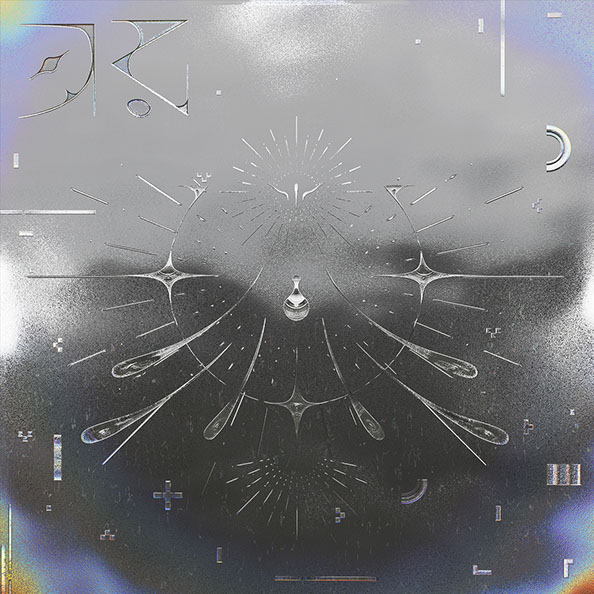
- Outer-casing for the 'Pure Grey Circle' Lei Disk.
______________________
Pure Grey Circle is a track written about a Dorset landmark known as the ‘Outer-Slateᴸᵒᵒᵖ.’ This winding wall of slate and granite runs along the circumference of the hill-top town that I grew up on. It is generally considered to be the boundary point between the town and the M⚮rlands. The Outer-Slateᴸᵒᵒᵖ is a natural phenomenon that predates the town itself, and functions almost as a strong magnet that disperses Lei Lines across the hill.
In tribute to the Outer-Slateᴸᵒᵒᵖ, we wanted to write a Lei Music piece that could summon an embodiment of the landmark. This was informed by recent research we’d conducted on a specific era of Dorset. During a forgotten age called the Niocene Epoch, there was an emergent subgenre of Lei Music that was written as devotional pieces to physical landmarks. In effort to perhaps contact or venerate a landmark, the Niocenic people would design songs to summon an entity that they interpreted as a projection of the inanimate subject. These subjects could range from revered geological structures to even just agricultural land.
We recorded Pure Grey Circle during torrential rain, situated at the upper-central point of the hill. We were attempting to be as close we could get to the Outer-Slateᴸᵒᵒᵖ’s innermost median point. Up to our ankles in mud and blasted by gales, our high-altitude view displayed the infinite panorama of the M⚮rlands. Despite the dizzying scenery, the trip’s focus was fixated on the hill itself, and the looping wall that defined it. We wanted the song to sound drastic, composed of pummeling peaks & drops like the landscape’s formation. The hymnal lyrics are in reference to how the town’s hemispherical structure is a result of eons of Lei Music summons. The constant cycle of mineral deposition & quakes caused by unpredictable summoning has resulted in a gradual build up of the mound over eons.
ˢˡᵘᵐᵖᵉᵈ ᶦⁿ ᵗʰᵉ ᵐᵘᶜᵏ, ᵗʰᵉʳᵉ'ˢ ᵃ ʳᶦᵈᵍᵉ
ᴸᶦᵗᵗˡᵉ ᵇˡᶦᵖ ᶦⁿ ᵗʰᵉ ᵈᶦʳᵗ ᵃⁿᵈ ᵗʰᵉ ᵐᶦˢᵗ
ᴸᵉᶦ ˡᶦⁿᵉˢ ˡᵉᵃᵈ ᵗʰʳᵒᵘᵍʰ ᵃ ʳᶦᶠᵗ
ᴾᵃʳᵗ ᵗʰᵉ ˢᵒᶦˡ ˡᶦᵏᵉ ᵃ ᵍᵃᵗᵉ
ᴿᶦᵖᵖᶦⁿᵍ ᵗʰʳᵒᵘᵍʰ ᵗʰᵉ ᵉᵃʳᵗʰ ᵃⁿᵈ ᵗʰᵉ ᶜˡᵃʸ
ᴹᵃᵖˢ ˡᵉᵃᵈ ᵗᵒ ᵗʰᵉ ᵍᵃᵖˢ ᶦⁿ ᵗʰᵉ ˡᶦᵍʰᵗ
ˢᶜʳᶦᵇᵇˡᵉᵈ ᶦⁿ ᵗʰᵉ ᵍʳᵒᵘⁿᵈ ˡᶦᵏᵉ ᵃ ᵛᵉᶦⁿ
ˢⁿᵉᵃᵏ ᶦⁿ ᵗᵒ ᵗʰᵉ ʷᵒʳˡᵈ ˡᶦᵏᵉ ᵃ ᵗᵃᵖ ʷʰᵉⁿ ᶦᵗ ᵈʳᶦᵖˢ
ᵀᶦⁿʸ ˡᶦᵗᵗˡᵉ ᵍʳᶦⁿ ᶦⁿ ᵗʰᵉ ᶠᵘᶻᶻ ᵒᶠ ᵃ ʳᶦᶠᵗ
ˢʰʳᶦᵉᵏᶦⁿᵍ ᵒᵘᵗ ᵗʰᵉ ᵍʳᵒᵘⁿᵈ ᵘⁿᵗᶦˡ ᶦᵗ ᵇᵘʳˢᵗˢ / ᵐᵃᵏᵉ ᶦᵗ ᶜʰᶦᵖ
ˢᵘᵇˢᵗʳᵃᵗеˢ ˢᵖˡᶦᵗ ˡᶦᵏᵉ ᵃ ᵇˡᵃᵈᵉ ᶦⁿ ᵗʰᵉ ᵖᶦᵗʰ
______________________
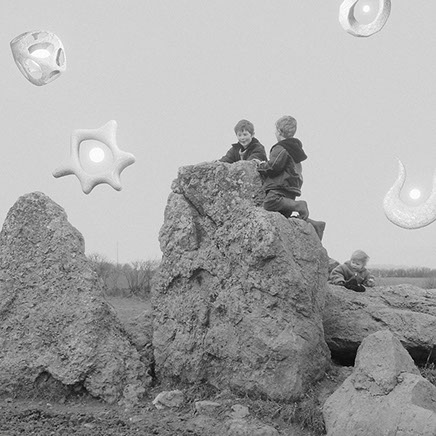
- The author & siblings climbing on a protrusion of the Outer-Slateᴸᵒᵒᵖ’s walls, 2004.
______________________
‘Sylph Fossil’
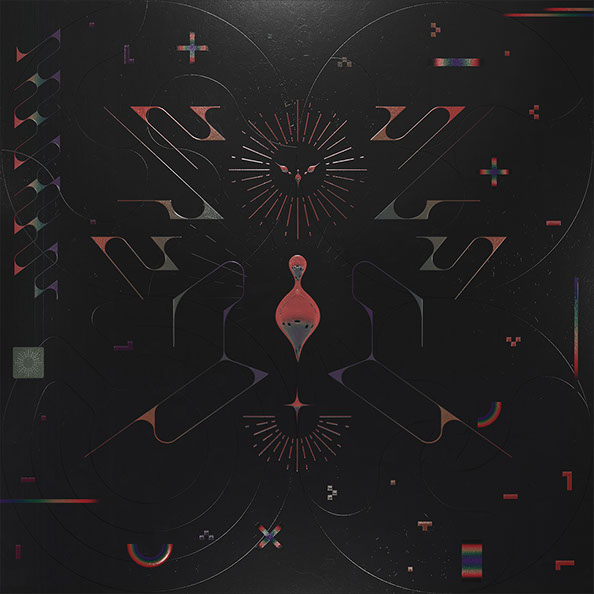

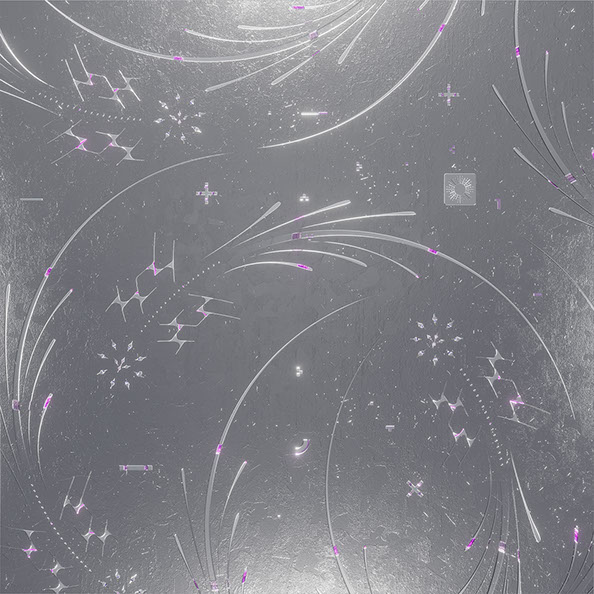
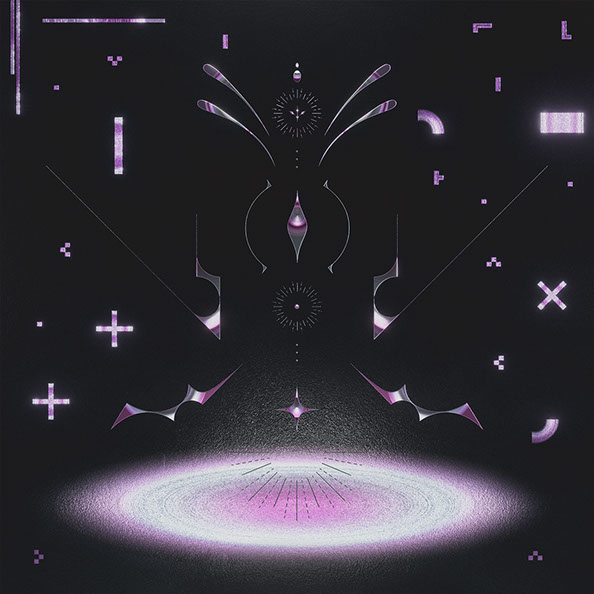

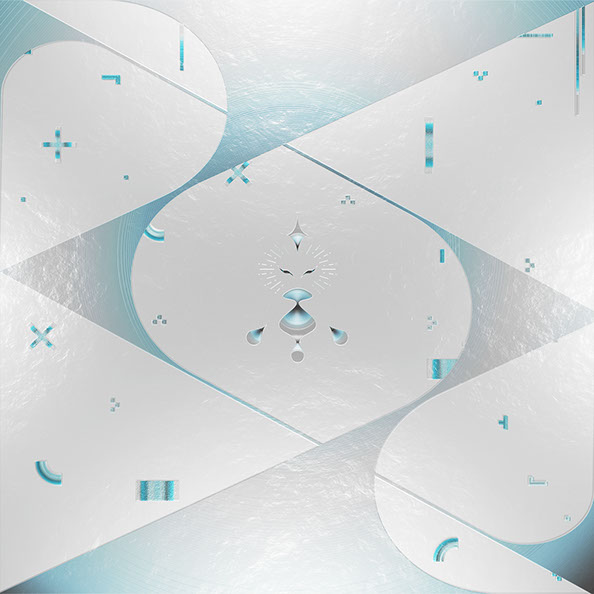

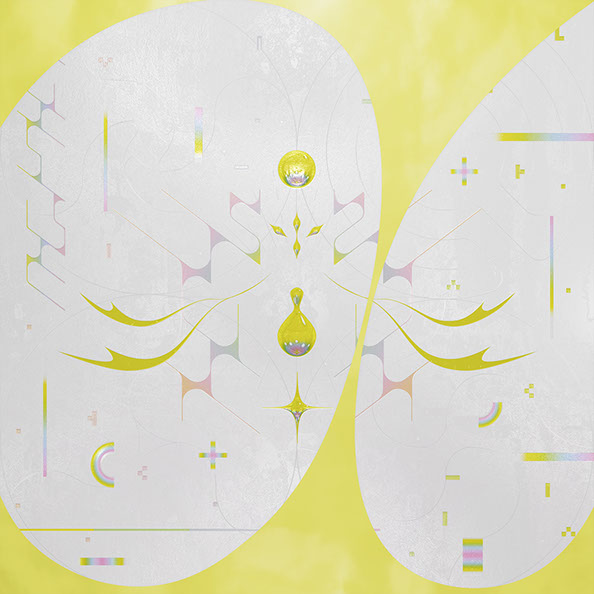
- Outer-casing for the 'Sylph Fossil' Lei Disk.
______________________
The development behind Sylph Fossil was a strenuous process, involving 324 scrapped proto-builds that are sitting in our vaults. We shared some selected demos of the track, as well as the story behind the piece in Entry 03.
The main breakthrough we achieved from developing a working model of Sylph Fossil was in learning how to quell the rage of a destructive entity. Over the course of the 324 attempts, we began to become accustomed with how the being responded to certain musical movements. Gradually, we conditioned ourselves to write the track around the mood and response of the entity - resulting in the finished version of Sylph Fossil that exists on the album.
‘Instead of trying to dispel intensely furied or timid movements - the most fruitful approach was to compose a piece that harmonised with the entity’s dueling insides. The being could manage to cooperatively dance in jarring swoops to contrasting tonal motifs. It hungered for battering strikes of iron-cladded drum tones to be followed with microscopic, squeaking melody sequences. In the final piece, we attempted to harness this dichotomous, constant switching of ruin & silence - finally managing to maintain an uninterrupted communion with the entity.’
This sequence of interactions allowed us to conclude that these Lei entities exist beyond the will of the musicians. They seem to possess autonomy to a degree, and visit us expecting a rapport of some kind. We feel that Lei Music’s history of constantly environmentally damaging summonings is in part a result of the misconception that entities are entirely subservient to the musicians’ compositions. In actuality, these interactions work best when they are approached as pan-dimensional tugs of wars, or duets with the ether.
______________________
‘Light Gutter’
- Outer-casing for the 'Light Gutter' Lei Disk.
______________________
Light Gutter is a track spurred from a specific subject matter that has haunted our research from the inception of the Glyph Institute². While Lei Music is regarded as an earthbound, folkloric tradition that spans the width of many eons - there is an inherent & undeniable factor of ecocide that has entwined itself throughout Lei Music’s history. Mining for special materials to forge Lei Disks or to innovate instruments has been a pursuit that has grown exponentially out of control during the last 12,000 years. During the Heliocene, the ancient ancestors of Dorset realised exotic materials and minerals were hidden ever so slightly underneath the ground they stood on - but as the epochs progressed, people dug deeper and deeper. A general rule of thumb is that the closer to the earth’s core you excavate, the more unfathomable & boundary-pushing the resulting Lei Music created with the materials is.
Dotted throughout the M⚮rlands, you can observe chasms that run exceedingly deep into the earth. These holes are known as Light Gutters, and are the result of eons upon eons of excavation. Vile, luminous smog drifts out of Light Gutters, released from punctured rocky substrates and high-pressure minerals being obliterated by mining. The fumes can be seen for miles due to the luminous appearance, and alarmingly seem to repel all Celles from the general vicinity. Celles are considered the natural inhabitants and patrolling sattelites of the M⚮rlands, & human interference causing them to disappear is deeply alarming. They are believed to be the arbiters that facilitate communication between worlds - & the fallout of Light Gutters could be putting our relationship with them at risk.
The piece ‘Light Gutter’ was performed in the outer-M⚮rlands in an environmentally ravaged area, while we undertaking maintenance on the nearby structures. The corner of land showed signs of once-dazzling monolithic structures and impressive geological scenery, but had been left destroyed by past Lei Music summonings. After spending several days camping out in a nearby granite alcove, we attempted to rebuild the blown-apart structures - and managed to reawaken a Lei Line that had been short-circuited by the destruction.
Using the Lei Line, we communicated with a velvety, lilac being with flowing, ribbon-like appendages. Parts of the entity appeared faded and damaged - including an unformed circular flare that nearly surrounded its upper-body, and a faint remnant of structure above the ‘face.’ While still elegant, the being appeared staggered by some kind of looming weight, unable to float and dance as you would imagine.
ᴵ'ᵐ ʰᵉᵃᵛᶦᵉʳ ᵗʰᵃⁿ ʸᵒᵘ ᵃʳᵉ
ᴬᵗ ʸᵒᵘʳ ᵇˡᵃᵈᵉ, ᴵ ᵐᶦᵍʰᵗ ᶜʳᵘᵐᵇˡᵉ
ᴵ’ᵐ ʳᵒᵒᵗᵉᵈ ᶦⁿ ʳᵒᶜᵏ ᵃⁿᵈ ˢᶜᵃʳˢ
ᴮᵒᵘⁿᵈ ᵗᵒ ʳᵘˢᵗᵉᵈ ᶜʰᵃᶦⁿˢ, ᴵ ⁿᵉᵛᵉʳ ᵏⁿᵉʷ
ᴬⁿʸᵗʰᶦⁿᵍ ᵇᵘᵗ ᵗʰᵉˢᵉ ʰᵃʳᵈᵉⁿᵉᵈ ʰᵃⁿᵈˢ
______________________
‘Big Protector’
- Outer-casing for the 'Big Protector' Lei Disk.
______________________
The field trip that the song ‘Big Protector’ was first performed at has been covered in detail in Entry 04 - but we’ve also since touched upon some major breakthroughs while pondering over the aftermath of our research.
A ‘Big Protector’ is the colloquial name given to a particularly enormous type of Celle that cyclically appears in the M⚮rlands on rare occasions. Composed of countless smaller Celles, the Big Protectors assume a huge, looming clam-like form. This song was written in attempt to establish some kind of back-and-forth with a Big Protector, and to inspect as much of it’s biology as we were able to.
We committed months to deep analysis of the footage that was acquired from sending a ‘ᴰᵉᵘˢScope’ drone to survey the inner-core of a Big Protector. We had actual visual evidence of some kind of vast landscape within the Big Protector’s body, but no information beyond what we could observe. Many theories were pitted against eachother inside the analysis-arm of the Glyph Institute², but without further studies conducted; all we could muster up was mere speculation. Eventually a newfound interest drew towards enhanced footage of strange, spritely organelle that bobbed around in the spacious, womb-like inner-core. They were unlike anything we’d ever seen before… taking the form of breathing liquid mercury wisps, adorned with dimly glowing spore-like lanterns. They squirmed and lit up in perfect synchronisation with our live recording of the audio… somehow dancing and mimicking our Lei Music despite being miles away in an amniotic biome. We colloquially named them Mint⟡Quarks (M⟡Qs), on account of their tiny size and subtle colour. These things were the key to Lei Line Eon’s next piece in the tracklisting…
______________________
‘UI Birth’
- Outer-casing for the 'UI Birth' Lei Disk.
______________________
‘UI Birth’ is a song with a unique conception. It is standalone in the tracklist as a piece that was partially composed without aid of any physical or digital instruments. As bizarre as that may sound, new research surrounding M⟡Qs made this possible for us to experiment with.
We were working on a separate track titled ‘Soil Bolt’ which involved a large amount of research into Celle biology. During a botched attempt at sending a drone into the body of a Celle, we were forced to cancel the task & retrieve the drone prematurely. Before disposing of the device, we actually found traces of M⟡Q particles attached to it’s extremely heat-resistant body - so we freaked out and incubated the M⟡Q in the institute. Some of my friends were working on a way the M⟡Q particles could potentially be used to make music, while I was mostly working on my laptop in the studio room to little avail.
‘UI Birth’ is all about obsessively manipulating data to induce awe - and how redundant that feels when you take a step back from this obsessive process. It arose from a time mid-way through the album writing process I was feeling burnt out; trying to reconcile with the fact people have been pulverising the earth for millenia with Lei Music… but for what end? For curiosity’s sake and to indulgently chase moments of awe was what I concluded… but it just felt so excessive when nature is already cool and more than enough. I’d take bike rides after tedious hours of writing shitty unfinished music, and find myself bugging out over just normal shit like the sun or the way crops blow in the wind. It all felt inherently better and more real than these pale imitations I was trying to write at the studio. This whole mindfuck lead me to writing the hymnal lyrics to ‘UI Birth’ - words that somewhat orbit around making Lei Music or any art, at worst, can become mere clinical tweaking of parameters and combinations.
ˢᵖᵉʷ
ᶜᵒˡᵘᵐⁿˢ ᵐᵃᵈᵉ ᵒᶠ ˡᶦᵍʰᵗ
ˢʰᵒᵒᵗᶦⁿᵍ ᵒᵘᵗ ᶠʳᵒᵐ ᵃ ʰᵘˢᵏ
ˢᵖᵉʷ
ᵀʰᶦⁿ ᶠˡᶦᶜᵏᵉʳᵉᵈ ˡᶦᵍʰᵗˢ
ᶠᵒʳᵐᶦⁿᵍ ˡᶦᵐᵇˢ ᶦⁿ ᵗʰᵉ ᶜᵘˢᵖ
ᵂᵉ'ʳᵉ ʲᵘˢᵗ ⁿᵒᵈᵉˢ
ᶠᶦᵍᵘʳᵉˢ, ᵛᵃˡᵘᵉˢ, ʷᵉᶦᵍʰᵗˢ
ᴵ'ᵐ ᵃ ᶜᵒᵈᵉ
ᴾᵒᶦⁿᵗ, ᵛᵒˡᵘᵐᵉ, ʷᶦᵈᵗʰ
ᴼᶠᶠˢᵉᵗ ᵈᶦᵍᶦᵗˢ ᶦⁿ ᵃ ˢᵗʳᶦⁿᵍ
ᵁⁿᶦᵗˢ ˢʰᶦᶠᵗ, ᵇᵒᵈᶦᵉˢ ᵗᶦⁿᵗ
Finally feeling like I had the start of something cool, we recorded those lyrics with a rough version of the verse instrumental. I took the sketch downstairs to the testing facility to find that my friends at the lab were rigging up this really strange peripheral device that utilised the M⟡Q particles. We wanted to verify what degree of influence the particles had on Lei entities, and this device allowed us to finally observe this relationship in a controlled environment.
The rough piece of music was played back through the DAW, and sure enough - the M⟡Q particles began flickering in synchronicity. A disjointed, bright magenta entity was beginning to emerge inside the testing chamber, but naturally we were more fixated on the now-observable reaction between the Lei Music and the M⟡Q. They appeared to be flashing some kind of morse-esque code that aligned with the DAW’s output… which then went on to effect the entity’s appearance and behaviour. It was almost like our Lei Music was dialling an operator (the M⟡Q particles), which then would make contact with the Lei Entity. Astounded, we began just running raw data out of the DAW instead of actual music. Button mashing random lines of morse caused the M⟡Q particles to light up in frantic patterns, and fed audio back to us as a byproduct. It felt like we’d turned Lei Music inside out - or as if we were making it in reverse. The resulting entity was sporadic, ever-morphing, and felt mindlessly generated.
The audio was definitely interesting to us, so we kept it and used it as the song’s first and second crescendo. UI Birth is one of my favourite tracks on the album… but I think the ethics behind it are a little conflicting. I felt like it deserved a place on the final tracklist because it explores how far from the light you can stray with Lei Music, & the feverish, giddy rush you can get from pushing thought-experiments slightly too far.
______________________
‘Zones U Can't See’
- Outer-casing for the 'Zones U Can't See' Lei Disk.
______________________
Contrary to a track like ‘UI Birth’, the next piece in the tracklisting arose from a more straight-forward approach. ‘Zones U Can’t See’ was the result of a fast-paced evening session in the studio. Ideas were flowing fast, and the writing process finally felt seamless for a rare moment.
I was kind of fatigued from the overly-calculated approach to Lei Music that we’d been hammering out as of late, so I wanted to work this piece into something that felt more speculative. Lei Music in Dorset has a fairly well-preserved history due to the county’s appropriate geological make-up - but I found myself ruminating on all the unknown subgenres and artifacts that have been lost to time in faraway counties where the geology doesn’t allow for fossilisation or preservation. Maybe similar things to Lei Music existed in these zones… but all evidence has turned to dust in a chalky substrate. Maybe the tools they used to make music were made from bark or organic coral-like materials - mediums that decay into ooze quickly.
While writing ‘Zones U Can’t See’, I integrated some coastal radio transmissions I was picking up from the South Eastern side of the country. It sounded like a baby yelling a strange rap, & I attempted to weave rhythmic patterns around it - while imagining the folk traditions of other towns lost to time. Bathed in the lime-tinted emanations of the entity I had been feeding ideas back and forth from - I felt renewed and hyped from this simple & fresh approach. I like this track a lot.
______________________
‘Amu (Disk•Mod)’
- Outer-casing for the 'Amu (Disk•Mod)' Lei Disk.
______________________
‘Amu (Disk•Mod)’ is my own interpretation of a childrens’ hymn originally titled ‘Amu’, or sometimes ‘Amu’s Hoop’ that originates from somewhere in the South East of the country. The song’s lyrics seem to be loosely inspired by a 1900’s Lei Music summoning that we’ve been studying since April of last year. This event was noteworthy due to it taking place halfway across the country from Dorset - in a place without any recorded evidence of Lei Lines. Further details surrounding the summoning are scarce, and the general lack of explanation led to local fascination & almost mythological exaggeration from the local townsfolk. The 1912 Amu summoning had singlehandedly revived the tourism industry of a struggling coastal town - spurring novelty records, cartoons, artwork, and cheap memorabilia.
In the spirit of cross-county folkloric trading, I wanted to re-record ‘Amu’ with a children’s choir and work it into a functioning piece of Lei Music. It felt full circle to see a Lei summon spur a dodgy homage song that eventually turns back into an actual Lei Music song. Although it was a bit of a logistical nightmare, I also set the challenge of designing the new instrumental to summon a Lei Entity with the rough appearance of the 1912 Amu summoning. The entire process of working on the track with the choir took months, but the result is something I’m proper proud of. I couldn’t summon an entity with that ghostly, bulbous appearance that the 1912 painting possesses - but instead I figured out a more Dorset-esque, disjointed & impressionistic structure (depicted on the above artwork.)
______________________
‘Soil Bolt’
- Outer-casing for the 'Soil Bolt' Lei Disk.
______________________
At the point that we had around 65 pieces written for the album, and a shortlist of around 8 solid keepers - I decided to go a little off-road and include a song that emerged from a different approach. Generally the process so far had been to create tracks that contained cross-pollenated elements from one demo to another, but I felt the need to diverge a little when we discovered a particular artifact.
A friend at the lab had been working on transcribing some abyssal hymns that dated back to the Ouacene. One particular extract grabbed everyone’s attention…
A ԃσɱαιɳ σϝ ʅσσɱҽɾʂ . . .
Bʅσƚʂ . . . ʅιƙҽ ɠιαɳƚ ԋσɱҽʂ ɱαԃҽ ϝɾσɱ ԃҽɯ . . .
Bσʅƚʂ σϝ ʂσιʅ ʂƚɾιƙҽ ƚԋҽ ϝʅσαƚҽɾʂ . . .
Aɳԃ ʅσ, ƚҽɳʂ ʂρʅιƚ ιɳƚσ ƚԋҽ ƚԋσυʂαɳԃʂ . . .
Iɳƙ ԃɾσρ ɠυαɾԃιαɳʂ ʂρʅιƚ αɳԃ ƚҽαɾ . . .
Dιʂρҽɾʂιɳɠ ιɳƚσ Ⴆιɠ ρɾσƚҽƈƚσɾʂ . . .
Though vague and painterly in tongue, it seemed to describe type of M⚮rland inhabitant that actually split into the Big Protectors - perhaps akin to how Big Protectors split into Celles. I became a little obsessed with the imagery excavated alongside the Oacenic hymns… these depictions of bizarre amorphous angels shaped like glowing beans. We scanned them up & even tried creating our own digital artwork and reinterpretations.
We also became fixated on trying to figure out why M⚮rland inhabitants look the way they do - so distinctly separate from Lei Line entities. Celles are these asymmetrical, wonky little satellite things… they feel like components or the cogs and circuitry of something bigger… and while Big Protectors are more symmetrical and cohesive in anatomy - they’re still embellished by nodules & patterns & complex details that look like they could interlock into something larger.
The imagery surrounding that transcribed poem seem to depict huge, simple, ovular beings with very little detail or imperfections. Instead, the visual interest is in the multicolour light rays spilling out of their central point - with glyphs and pictorial scribbles spewing out. If these beings were ever even real, they were probably long-gone… but we couldn’t help but dream up hypotheses on how far this proposed model could go. Celles merge to form Big Protectors, Big Protectors merge to form ‘ϝʅσαƚҽɾʂ’ - and even they merge together to form something even purer, ad infinitum.
Myself and a gaggle of folk who work at the institute were huddled into the studio, jotting down ideas and sketches relating to this emerging idea. Some people were painting or writing, but a bulk majority of us were noodling song ideas, trying to summon entities that looked like the things we were imagining in our heads. The discussions and proposals ran throughout the night and into the dawn chorus. Bleary-eyed, I extracted a section of the Lei Music we had been sketching the day after, & decided to include it on the album - that file was ‘Soil Bolt.’
______________________
‘Yellow Umbra’
- Outer-casing for the 'Yellow Umbra' Lei Disk.
______________________
In the final months of writing the album I was busy tidying up mixes, fixing errors, and exporting finalised versions of prototype-builds. Despite the torrent of micro-tasks and demanding work, no single member of the Gylph Institute² could stop their minds from wandering back to the night we recorded ‘Soil Bolt.’ This idea of the Celles being the youngest in a family tree of fractured divided lifeforms, all stemming from one whole, pure, original being… it felt like perhaps we were stumbling towards a hallmark discovery as an institute. This initially cultish whisper became something we all said out loud, and something that we found ourselves longing to maybe even prove one day.
Closer to the start of the album writing process, the research institute temporarily split into two units. One group ended up writing Sylph Fossil (as documented in Entry 03), while the other group was investigating the possibility of a pure, uninterrupted Lei Line. When choosing a location to perform Lei Music, musicians have to tap into the Lei Lines with Daosing Rods. This forms a passable but imperfect connection, and leads to ‘colouring’ and warping the summon in different ways. Group B was trying to see if there’s a possibility to ever establish a perfect connection that avoids any colouring or warping. It finally seemed that their efforts had proved fruitful, after countless false starts and disasters. Utilising formulas found in the recently excavated Ouacenic texts, Group B were convinced they had forged Daosing Rods capable of frictionless Lei Line transmission capabilities.
For the album’s last track, we felt that using these new rods was a no-brainer. The biggest moral dilemma on our hands was the fact we had no real idea of how dangerous an entity would be when divined through uninterrupted Lei Lines. Perhaps all the warping and signal impurities established a dulled shield of safety. We just didn’t really know, but also felt uncomfortable taking the project out into the M⚮rland and risking even more ecological destruction. Eventually, we reluctantly decided on using the original Glyph Institute¹ grounds as the testing grounds for our piece.
______________________
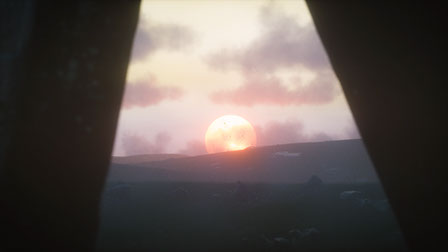
-Ruins of the original Glyph Institute¹ grounds, p. CC Denton.
______________________
The Glyph Institute¹ is an ancient research community that we half-jokingly took our namesake from. Fading into obscurity during 1800’s (as Lei Music temporarily entered a drought period), their original headquarters has been left in ruins. Research under their group’s name has been scant & rare ever since, aside from the occasional paper leaking into the public domain (such as the 1912 Amu summon.) Their most esteemed contributions to Lei Music research have been groundbreaking, however their methods & attitude appear barbaric and heedless by today’s standards.
With the news of the innovated Daosing Rods, I was fairly dumbfounded on what music to even prepare for this last summon. Flicking through pages & pages of archived literature and picture books that we’d stored in our institute’s libraries, I succumbed to the only convincing idea I could reach. I wasn’t really sure if this was the most cohesive finale - but I thought maybe it could be a piece that evokes every single known period of Lei Music. Something about it didn’t really sit right about it with me… it kind of felt like a flashback or some kind of self-congratulatory history lesson. Despite this, it was the most appropriately grandiose concept I could develop with the time constraints, so I had to run with it.
At the scene of our last piece, members of the team Daosed for the best spot in the area. I was sat on a big rock trying to prep this garbage piece I’d been tweaking all week. It was just so literal… the transitions were total shite. The nerves were starting to get to me until the Daosing team had finally found a decent spot - at that point I just wanted to get it done and over with.
______________________
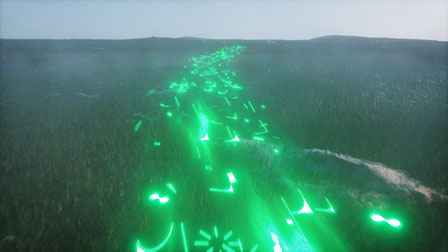
- Lei Lines surging, p. CC Denton.
______________________
The second the Daosing Rods emitted their tonal hum, everyone on-site could tell these things were the functioning as intended. It was the loudest silence I’d ever heard - a piercing, eardrum-shattering nothing that sucked out any background ambience like a vaccuum. I tapped ‘initiate’ on the DAW, and somehow just the impact of the click kickstarted the summon. A yellow flare crept out of the atmosphere & spread around the ruins like a flash-fire. I trembled my way through the opening passage of the track, scrolling through a comprehensive sample library of 12000 years of Lei Music history. The laptop was struggling to run on overboost in the heat and the audio was synchronising fast enough - resulting in archival samples being warped across a gridless, formless composition. The entity thrashed itself across the site of the ruins, as if it was being pummeled by an invisible, violent force.
After sections upon sections of trying to bring the piece new places, from syncopated, digitally belching stabs, to naturalistic physically modeled passages… everything just seemed to strain the entity further. I began to feel it was trying to demonstrate the endless burden & torment the land has endured in the name of advancement. Every human era referenced in the piece evoked geological scars & memories of abrasion. To combat this, we needed to tap into everything we had learnt as an institute. Communicating with an entity is about a mutual, echoing bond. My nerves had lead me to improvising a technical fireworks display of contextless references and uninformed musical guesswork… which lead the entity to suffer through a vivid memorial of earthen grief.
We began to attempt to shift the piece towards a place of drive + intent. The entire ensemble gradually reached the same page, and began to react their playing to the pained shrieks and bellows of the entity. The composition blunted itself into a gradual stillness - a wall of softened tranquility to euologise the quiet that predated the epochs of noise. We sundered this peace with jagged thuds & crackles, attempting to paint a shared understanding of the bruises inflicted on the land. We repeated this movement from order to disorder again & again. Gradually it seemed that throughout the musical passages of sombre calm, the entity fluctuated slowly & took the form of a slow-motion flare. Throughout the passages of disorder and noise, the entity darted through trillions of alternate forms; pantomiming infinite iterations of past summons.
______________________

-Mapping of the summon's light fluctuations.
______________________
As we moved through these looping movements, we began to exponentially decrease the pace until the final calm was drawn out for as long as we could physically withstand the heat. Assuming an unmoving form of pure light, the flare enshrouding the entity dimmed the more we withheld the final note. Right before our equipment approached melting point, a perfect being could be seen through the subsiding glow for a split second. For some reason we immediately knew its name was Aœ. Hours after the summoning, residual howls and creaks from the beyond could still be heard reverberating around us. Strange little yellow comets and floaters littered the horizon line.
We don’t really know what Aœ was, and we will most likely never recite the piece again. Some of us think Aœ told us that it is every entity ever summoned… and that every ‘Lei Entity’ is just Aœ’s data being warped and manipulated through faulty connections & contorted links. Some of us think the Daosing Rods weren’t purified, and the technology can never actually be perfected. Some of us think that presuming Lei Entities are actually communicating anything at all is just the product of pareidolic, arrogant human projections. Somehow the entire institute has never been this ideologically splintered until after the recording of ‘Yellow Umbra’ - but we’re happy that the album ends on a note that proposes a dizzying multitude of questions. Some days I’m convinced Aœ is the original, pure being that went on to split into Floaters, Big Protectors, Celles, etc. - and through Lei Music we are channeling blurred visages of its archetypal form. Some days I’m convinced Lei Music is actually using Celles as pan-dimensional telephones to contact confused fauna from other worlds. Some days I’m even semi convinced everyone is drinking poisoned tap water in Dorset from the old lead pipes and this is all delirious mirages. I really don’t know.
One consensus that everyone in the Glyph Institute² can harmonically reach is that to understand any of this, we need to first & foremost protect the land from our own shortsighted, accelerated sapping of its lifeforce. The Celles are disappearing as holes in the ground leak gas that should never touch the daylight. We disrupt, obliterate and take too much, sometimes in the name of an artform that is supposed to bring us closer to the soil. The maps leading to the gaps in the light are all around us, & we cannot afford to pummel them into dust.

Gylph Institute² grounds, p. CC Denton.
______________________
╰ ⋵ ⋰☗∰፨☼⑇ DIRECTORY . . .
Entry 01: Introduction to Lei Music, etc.
Entry 02: Daosing, Pebble Networks, etc.
Entry 03: Sylph Fossil development, proto-builds, etc.
Entry 04: A new expedition, communication with the Big Protectors, etc.
Entry 05: Lei Line Eon - Disk by Disk, etc,
______________________
Follow @Iglooghost:
INSTAGRAM • SPOTIFY • TWITTER • SOUNDCLOUD
______________________
PUBLISHED BY S.MAL / @IGLOOGHOST
May 31, 2021
╰ ⋵ ⋰☗∰፨☼⑇
DIRECTORY . . .
Entry 01: Introduction to Lei Music, etc.
Entry 02: Daosing, Pebble Networks, etc.
Entry 03: Sylph Fossil development, proto-builds, etc.
Entry 04: A new expedition, communication with the Big Protectors, etc.
© 2020 - 2021 | Glyph Institute² | Council Of Lei